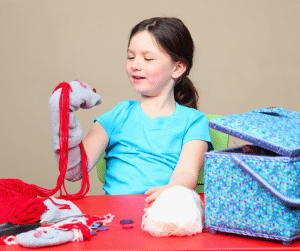Did you know that 1% of the Australian population has a stutter?
Stuttering can affect children, adolescents and adults across the lifespan, making it a widely spread speech difficulty.
But what is a stutter really? How do stutters start? What causes stuttering? And most importantly, how do you fix a stutter?
You’ve got questions, Spot Speechies Janet and Cass have got the answers!
Keep reading to learn all about stutters and how Speech Therapists can help you or your loved one to overcome a stutter.
Stuttering can affect children, adolescents and adults across the lifespan, making it a widely spread speech difficulty.
But what is a stutter really? How do stutters start? What causes stuttering? And most importantly, how do you fix a stutter?
You’ve got questions, Spot Speechies Janet and Cass have got the answers!
Keep reading to learn all about stutters and how Speech Therapists can help you or your loved one to overcome a stutter.

What Is Stuttering?
Stuttering (known as “fluency” to us Speechies!) is a common speech disorder in which a person often knows exactly what they want to say, but has difficulty saying it.There are 3 types of stuttering: developmental, psychological and neurological.
Developmental stuttering begins during childhood and is the most common type of stuttering. Although it begins in childhood, without intervention this type of stuttering may continue throughout a person’s life.
Psychological stuttering can develop following a traumatic event or period of high emotional stress, whereas neurological stuttering typically develops after a brain injury. These types of stutters are less common.
In typical speech, there are some disruptions to the flow of sentences, such as using ‘um’, ‘ah’ and ‘like’, or repeating a word twice. These are called disfluencies and many of us will experience them.
People who stutter have speech interrupted by a number of disfluencies that are not part of typical speech. These disfluencies can include:
- Repetitions – repeating a sound, part of a word or a phrase. For example: “b,b,b,bike” or “Sun, Sun, Sun, Sunday”.
- Prolongations – stretching the sound out for a long time. For example “Sssssit with me”.
- Blocks – halting or pausing of speech, making it difficult to get any words out. For example “Is that a (pause) new shirt?”.
People who stutter may also demonstrate other behaviours such as blinking their eyes, nodding their head or avoiding certain words to minimise their stuttering.

Famous People That Had (Or Still Have) A Stutter
While stuttering can cause a loss of confidence in the person that stutters, it’s important to note that many successful and famous people have experienced stuttering (and some still do to this day!). These include:- Marilyn Monroe (Actress)
- Ed Sheeran (Singer)
- Joe Biden (USA President)
- Emily Blunt (Actress)
- Kendrick Lamar (Rapper)
- King George IV (King of England)
- Samuel L. Jackson (Actor)
- Julia Roberts (Actress)
- Rowan Atkinson (Actor)
- Hugh Grant (Actor)
- Bruce Willis (Actor)
- Nicole Kidman (Actress)
- Tiger Woods (Golf Professional)
- Lewis Carroll (Writer of Alice in Wonderland)

What Causes Stuttering?
We’re about to get a little bit technical here for a moment, so stick with us!The most common theory of what causes stuttering is called the demands and capacities model. This model suggests that stuttering occurs when the demands for fluent speech are greater than the speaker’s capacity to produce it.
Demands for fluent speech include things like:
- Feeling pressure to speak quickly. This often happens in large families where children who don’t join in conversation quickly enough miss their turn to speak; when parents speak very quickly and thus model rapid speech to their children; or when children are not given sufficient time to answer questions or make comments.
- Being in a high-pressure situation, such as when asked to answer a question in front of the class.
- Reduced motor control in the muscles of the mouth and face. This is common in children with disabilities such as Down syndrome or Cerebral Palsy.
- Any combination of reduced capacity or too much demand for fluent speech may cause a child to stutter.
- The ability to form words or sentences is still developing.
- Being in a heightened emotional state, such as when feeling nervous, upset, or excited.
Here are some other key facts about stuttering:
- Genetics plays a role in stuttering. This means that you are more likely to stutter if somebody else in your family does.
- It is much more common for men to stutter than women (by nearly five times)! However, stuttering occurs in roughly the same number of boys and girls.
- Stuttering is not caused by anxiety or nervousness, though these feelings may exacerbate an existing stutter.
- Stuttering generally emerges between the ages of 2 and 3, though it can emerge later. It can come on gradually or suddenly. Stuttering can also come on during adulthood due to stroke or traumatic brain injury.

Will A Stutter Go Away By Itself?
For some children, stutters do resolve on their own! However, for many children, this is not the case.Because there is no way to predict which children will get better without therapy, speech therapists will always recommend therapy for children who stutter (the earlier we can intervene, the better the outcome!).
We believe it’s better to err on the side of caution. This is because treatment for stuttering is most effective between the ages of four and six.
Therefore, if you wait to see if your child’s stutter will get better on its own, you run the risk that treatment will not be as effective.
Additionally, stuttering affects more than the way people speak. Even a mild stutter can have a big impact on a person’s confidence.
Left untreated, stuttering can lead to anxiety and have negative impacts on social relationships and occupational attainment in adulthood.

How To Get Rid Of A Stutter
When it comes to how to stop stuttering, a variety of strategies are used by Speech Therapists (including many techniques you can continue to practice at home, outside of therapy sessions).
If we think back to the capacities and demands model above, it makes sense that one of the first steps we would take is to try to reduce the demands placed on a speaker while increasing their capacity to produce it (this is the part where you can help!).
Here are our top tips for getting rid of a stutter:
1. Utilise Positive Reinforcement And Praise
When it comes to how to stop stuttering in children, the Lidcombe Program is an incredible resource.This behavioural program for children aged 6 and under focuses on the parent or caregiver commenting directly on the child’s speech (Lidcombe Training Program Consortium, 2013).
The Lidcombe Program is delivered by the parent with training required from a Speech Pathologist. The program is very structured and requires a lot of support from the parent (and us Speechies, of course!).
One key strategy used in this program is praise. The aim of this strategy is to give lots of praise following smooth speech such as:
- Great smooth talking!
- That was so smooth!
- Good job, you had no stuck words!
Your Spot Speech Therapist can teach you how to recognise stuttering moments versus smooth speech moments and provide positive reinforcement tips for smooth speech.
This will teach your child to tune into the way they are speaking and start working towards using smoother-sounding speech more consistently.
2. Change Up The Way YOU Talk To Your Little One
In more clinical terms, we call this ‘modifying your speaking environment’. This might involve changes like slowing down your own speech as a model to your child, or making sure your child has ample time to respond to questions or make comments.If there are always lots of people talking in your house, you might try passing around a special toy or ball that tells a person when it’s their turn to speak.
Anyone not holding the ball will have to keep quiet!
3. Try Speech Restructuring Techniques
Speech restructuring involves learning how to use a new speech pattern to reduce or eliminate stuttering moments while sounding as natural as possible.This approach is used for adolescents and adults more so than our youngest clients.
It’s important to note that stuttering in adolescents and adults cannot be cured.
Instead, speech therapy helps people who stutter beyond early childhood to learn how to control their stutter, reducing the impacts that it has on their daily lives.

Speech Therapy For Stuttering
Talking to people can be difficult for people that have a stutter and may cause frustration at any age.
But never fear, Spot Speechies are here!
If you believe you or your child may have a stutter and want to learn more about online speech therapy at Spot, click here to book your Free Consultation with one of our experienced Speech Therapists today.






